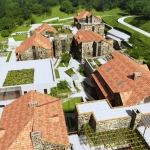By watching the course and disposition of the luminary in the firmament even the Stone Age man determined the hours of the day. Shadows cast by natural stone obelisks and the protruding erected bodies played significant role. Studying the semicircular path of a shadow from sunrise to sunset and dividing it into equal parts man took the first steps towards the discovery of sun-dials. After many centuries giving certain declivity to the stone columns (correspon ding to the equator plane or the latitude of the location) human being determined the exact hours of the day. The oldest sundials in the territory of Armenia are the obelisks of the 3rd millennium B.C. found in Shengavit, Mokhrablur and Aragats. The structure and location of these obelisks testify that they were used not only for ceremonies worshiping the Sun, but also to study the luminaries and to determine the hours of the day. The ring-shaped zones, engraved on the phallic stone monuments, found in Zvartnots, Karmir Blur and Metsamor, were also important for measuring shadows. After the declaration of Christianity as a state religion in 301 A.D. pagan temples were destroyed together with the sun-dials. However, soon the use of sun-dials continued in the form of vertical carvings on the southern walls of monasteries. This fact is confirmed by the sun-dial on Yereruyk Church, which dates to the early Christian period in the 5th century. Such sun-dials were placed on numerous religious buildings of Armenia in the territories of Zvartnots, Goshavank, Makaravank, Harichavank, Haghartsin, Tanahat, Ayrivank, Mshkavank and elsewhere. The majority of the medieval monasteries had their own schools, where famous scientists and philosophers worked. The rod, showing the hours of the sun-dials, was placed in parallel with Earth’s axis. The day was divided into 24 hours: 12 daylight and 12 night nighttime hours. The hours had their particular names. Some of the oldest manuscripts in Matenadaran testify to the wide use of the shadow-measuring sun dials in Armenia. Harutiun Martirosian, a well-known Armenian archeologist, who had studied a number of prehistoric sciences, wrote: “If Babylon was the native land of water clocks, Egypt was the native land of sand clocks, later Armenia was the native land of sun dials and lunar clocks, which characterized the history of Armenia and remained true to it”.
Sun Dials
Back To Top










